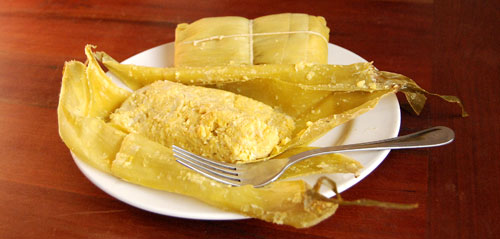Late summer in Chile tends to be one big corn fest. Green vegetables are sidelined and the markets fill up with ungodly sized corn, the size of rugby balls, that are used to make the sacred dishes of these sunny days: pastel de choclo (Chilean corn pie), porotos granados (creamy cranberry beans with pumpkin and corn), and humitas (fresh corn tamales with basil).
The corn here is different than in the US. For starters, it’s not sweet. Chileans do not dig sweet corn at all. In fact, to my disbelief last summer, my husband rejected Jersey sweet corn. I guess it depends on what you grow up with…While there may be some sugar sprinkled on top of the corn pie to caramelize, generally speaking, the corn here is used as a savory starch.
Humitas date back to pre-Colombian times and are prevalent in Chile, Argentina, Peru, and Bolivia, all with their respective variations. In Chile, they are prepared with freshly ground corn, chopped onion, copious amounts of fresh basil, and butter or lard (yes, pork fat). They are the polar opposite of the drier, filling Mexican-style tamales filled with meat. These fresh humitas are, for me, the symbol of summer time. They are a homey dish that your mother, grandmother, a maid, neighbor, or casera in the market makes–with a lot of love. They are quite time consuming to make. Oh, are they worth it!! Corn is transformed into a silky, creamy purée, spooned into cleaned husks, and tied together into tidy packages with cooking twine. When boiled to tender, they become slightly toothy but smooth. I could eat them every day, I swear. Yep, a corn fest indeed.
They are the perfect light lunch or dinner with the classic Chilean tomato salad. The taste of summer? Most definitely.
12 ears rugby ball-sized ears of corn, called humeros in Chile
1 large onion, finely diced
2 tablespoons pork lard, or butter
2 springs of basil, leaves removed, minced
2 green chilies, seeded, deveined, and minced
1 teaspoon paprika
1 cup whole milk
1/4 teaspoon black pepper, freshly ground
1 1/2 teaspoons salt
Carefully husk the corn. Select the largest leaves in good condition to be used for stuffing the humitas. Clean the ears of the silk and then remove kernels with a sharp kitchen knife. Place in a grinder or food processor; pulse until finely ground with some texture.
Heat the lard and fry the onion until translucent. Add the chilies, paprika, salt, pepper, and basil. Add this mixture to the ground corn along with the milk. Combine well. If the corn is “dry” and not milky, increase milk up to 2 cups to compensate. The mixture should be slightly thick but not overly dry nor runny. At this point, some cooks add a chopped peeled and seeded tomato and additional green chili for some heat.
To make the parcels, do this over a cutting board to catch any seepage of the mixture. Take two corn husks, overlaying them at their widest part. Lay another two corn husks, this time in the opposite direction, to form a cross. Holy humitas, right? In the middle, place several 1/3-1/2 cup corn mixture (depending on size of husks). You should be able to fold the parcel to be firm but not have it oozing everywhere. Don’t skimp on the filling either, who wants to open their “present” to find a weeny-sized humita?
To bring the parcel together, fold in horizontal sides, then the vertical ones and fold over to form a tightly sealed package. Wrap in cooking twine and secure tightly. Bring a large pot of salted water to a boil. Add a pinch of salt. Add the humitas and cook for 1 hour.
Eat hot. If saving for later use (freezer or refrigerator), be sure to let them cool thoroughly. Adding hot humitas to the refrigerator can make them go bad and curdle the milk, causing an unpleasant vinegary taste.
Yield: 12-16













